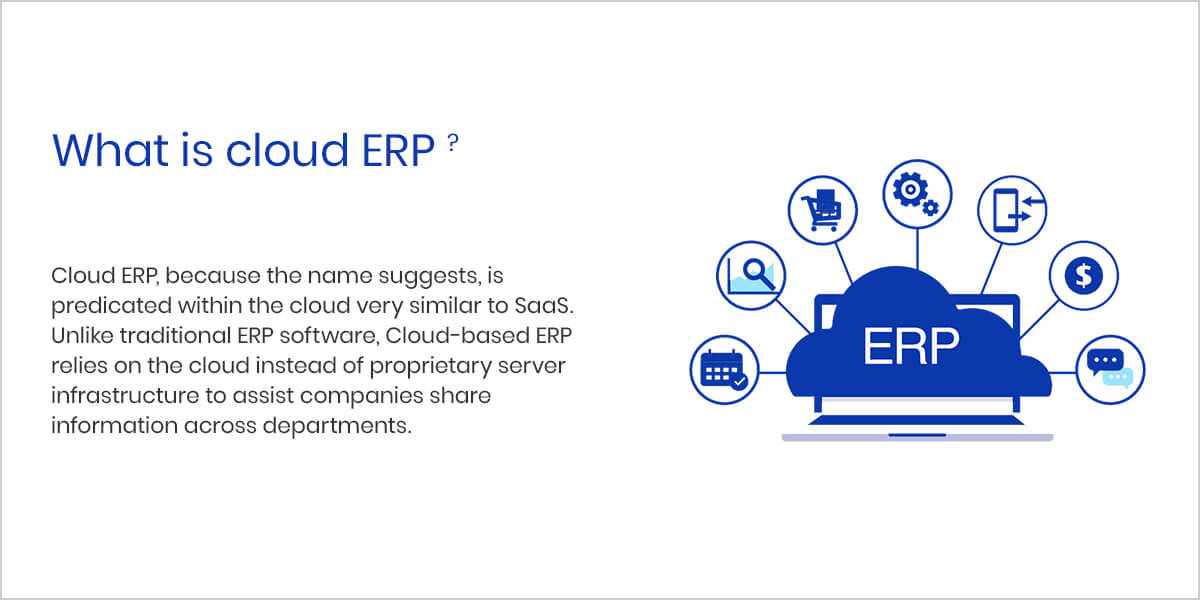What is cloud ERP?
- Cloud Based ERP September 11,2023

Cloud ERP is Software as a Service that permits users to access Enterprise Resource Planning (ERP) software over the web. While technically the sole difference between Cloud ERP and on-premises ERP is where the software is physically located, there are other significant differences. Here we explain a number of the key characteristics and advantages of Cloud ERP software.
The Cloud is especially valuable to small and medium-size businesses (SMB’s) because it provides access to full-function applications at an inexpensive price without a considerable upfront expenditure for hardware and software. Using the proper cloud provider, a corporation can rapidly scale their business productivity software as their business grows or a replacement company is added.
On-premises ERP vs. cloud ERP
The breadth and depth of obtainable modules can differ significantly between on-premises and cloud ERP products.
The gap has narrowed as ERP vendors have shifted most of their development effort faraway from on-premises versions to the cloud, and today many cloud ERP solutions include the broad range of functional modules. However, vendors still struggle to deliver comparable features in their cloud based ERP offerings, and on-premises ERP outsells cloud by a good margin.

One increasingly popular sort of cloud ERP, multi-tenant software as a service, or SaaS ERP, is usually a streamlined version with fewer modules and features than an equivalent vendor’s on-premises ERP. In multi-tenant SaaS, multiple “tenants” use an equivalent copy, or instance, of the software.
This scheme tends to enforce standardization and simplification, since equivalent software must serve customers with varying needs. It’s the most important reason SaaS ERP tends to possess fewer modules than on-premises ERP.
There are other important differences. SaaS ERP cannot be customized, for the foremost part, which may be a serious drawback for companies that spend years customizing on-premises ERP to satisfy their unique needs.
(SaaS proponents claim this is often a plus because it helps enforce industry best practices reduces IT costs and makes the ERP system less susceptible to bugs and crashes.) On-premises ERP usually requires an outsized upfront payment for a multiyear license, while SaaS typically comes as a monthly, per-user subscription, though some vendors offer pricing that mixes the 2 models.
Despite these differences, debates still rage about which deployment model is cheaper for ERP buyers within the end of the day. Vendors said SaaS is cheaper for them to take care of and has more growth potential from subscription revenue. Most try to wean customers off their aging on-premises ERPs but face resistance as companies question whether cloud ERP does what they have and is well worth the money.
Benefits of Cloud ERP
Companies can upload and access data in real-time via the cloud, from any device with an online connection, allowing greater collaboration among departments.
Cloud ERP software also has the advantage of being hosted on one platform. Having all of your business applications, like your CRM and accounting, for instance, on an equivalent cloud platform allows you to unify your systems of engagement together with your systems of record.
Rather than having your company’s front and back office applications in separate systems, using one cloud platform allows your apps to speak to every other, share a central database, get real-time reporting and use one interface.









 Saudi Arabia (English)
Saudi Arabia (English) United Kingdom
United Kingdom Global Site
Global Site